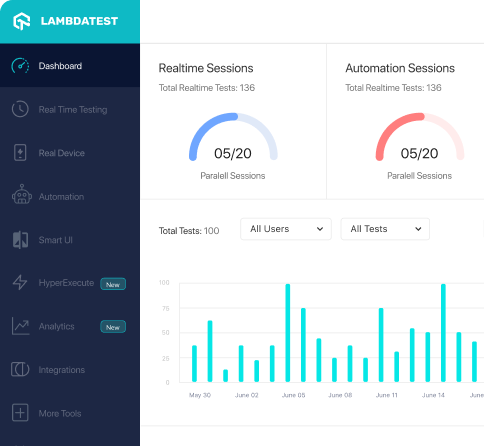How to use ReceiveHttpMessageTestDesignerTest class of com.consol.citrus.dsl.design package
Best Citrus code snippet using com.consol.citrus.dsl.design.ReceiveHttpMessageTestDesignerTest
...32import org.testng.annotations.Test;33/**34 * @author Christoph Deppisch35 */36public class ReceiveHttpMessageTestDesignerTest extends AbstractTestNGUnitTest {37 private HttpClient httpClient = Mockito.mock(HttpClient.class);38 private HttpServer httpServer = Mockito.mock(HttpServer.class);39 @Test40 public void testHttpRequestProperties() {41 MockTestDesigner builder = new MockTestDesigner(applicationContext, context) {42 @Override43 public void configure() {44 http().server(httpServer)45 .receive()46 .get("/test/foo")47 .method(HttpMethod.GET)48 .queryParam("param1", "value1")49 .queryParam("param2", "value2")50 .payload("<TestRequest><Message>Hello World!</Message></TestRequest>");...ReceiveHttpMessageTestDesignerTest
Using AI Code Generation
1package com.consol.citrus.dsl.design;2import java.util.HashMap;3import java.util.Map;4import org.testng.annotations.Test;5import com.consol.citrus.dsl.testng.TestNGCitrusTestDesigner;6public class ReceiveHttpMessageTestDesignerTest extends TestNGCitrusTestDesigner {7 public void receiveHttpMessage() {8 receive(http().server("httpServer")9 .post("/test")10 .payload("<TestRequestMessage><text>Hello Citrus!</text></TestRequestMessage>")11 .header("Operation", "sayHello"));12 }13 public void receiveHttpMessageWithExtractors() {14 receive(http().server("httpServer")15 .post("/test")16 .payload("<TestRequestMessage><text>Hello Citrus!</text></TestRequestMessage>")17 .header("Operation", "sayHello")18 .extractFromHeader("citrus_http_status_code", "status"));19 }20 public void receiveHttpMessageWithExtractorsAndValidation() {21 Map<String, Object> headers = new HashMap<String, Object>();22 headers.put("citrus_http_status_code", "200");23 receive(http().server("httpServer")24 .post("/test")25 .payload("<TestRequestMessage><text>Hello Citrus!</text></TestRequestMessage>")26 .header("Operation", "sayHello")27 .extractFromHeader("citrus_http_status_code", "status")28 .validateHeader("citrus_http_status_code", "200")29 .validateHeader(headers)30 .validatePayload("<TestResponseMessage><text>Hello Citrus!</text></TestResponseMessage>"));31 }32 public void receiveHttpMessageWithExtractorsAndValidationBuilder() {33 receive(http().server("httpServer")34 .post("/test")35 .payload("<TestRequestMessage><text>Hello Citrus!</text></TestRequestMessage>")36 .header("Operation", "sayHello")37 .extractFromHeader("citrus_http_status_code", "status")38 .validate(header("citrus_http_status_code", "200"))39 .validate(header("citrus_http_status_code", "200"), header("citrus_http_versionReceiveHttpMessageTestDesignerTest
Using AI Code Generation
1package com.consol.citrus.dsl.design;2import com.consol.citrus.dsl.runner.TestRunner;3import com.consol.citrus.dsl.testng.TestNGCitrusTest;4import org.testng.annotations.Test;5public class ReceiveHttpMessageTestDesignerTest extends TestNGCitrusTest {6 public void configure() {7 }8}Blogs
Check out the latest blogs from LambdaTest on this topic:
Most test automation tools just do test execution automation. Without test design involved in the whole test automation process, the test cases remain ad hoc and detect only simple bugs. This solution is just automation without real testing. In addition, test execution automation is very inefficient.
Coaching is a term that is now being mentioned a lot more in the leadership space. Having grown successful teams I thought that I was well acquainted with this subject.
Pair testing can help you complete your testing tasks faster and with higher quality. But who can do pair testing, and when should it be done? And what form of pair testing is best for your circumstance? Check out this blog for more information on how to conduct pair testing to optimize its benefits.
Let’s put it short: Appium Desktop = Appium Server + Inspector. When Appium Server runs automation test scripts, Appium Inspector can identify the UI elements of every application under test. The core structure of an Appium Inspector is to ensure that you discover every visible app element when you develop your test scripts. Before you kickstart your journey with Appium Inspector, you need to understand the details of it.
Recently, I was going through some of the design patterns in Java by reading the book Head First Design Patterns by Eric Freeman, Elisabeth Robson, Bert Bates, and Kathy Sierra.
Automation Testing Tutorials
Learn to execute automation testing from scratch with LambdaTest Learning Hub. Right from setting up the prerequisites to run your first automation test, to following best practices and diving deeper into advanced test scenarios. LambdaTest Learning Hubs compile a list of step-by-step guides to help you be proficient with different test automation frameworks i.e. Selenium, Cypress, TestNG etc.
LambdaTest Learning Hubs:
- JUnit Tutorial
- TestNG Tutorial
- Webdriver Tutorial
- WebDriverIO Tutorial
- Protractor Tutorial
- Selenium 4 Tutorial
- Jenkins Tutorial
- NUnit Tutorial
- Jest Tutorial
- Playwright Tutorial
- Cypress Tutorial
- PyTest Tutorial
YouTube
You could also refer to video tutorials over LambdaTest YouTube channel to get step by step demonstration from industry experts.
Most used methods in ReceiveHttpMessageTestDesignerTest
Try LambdaTest Now !!
Get 100 minutes of automation test minutes FREE!!



